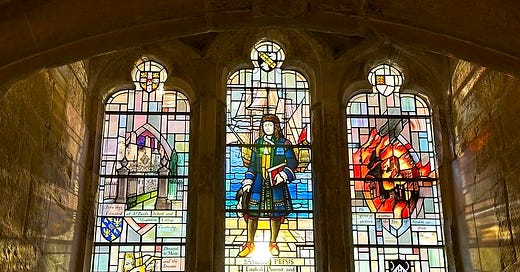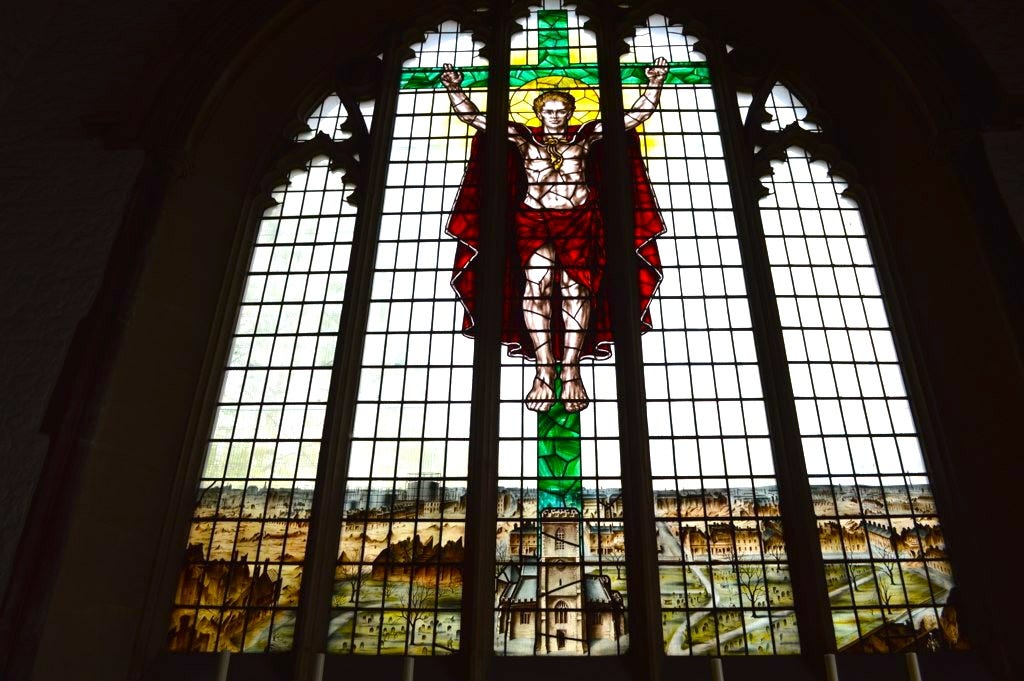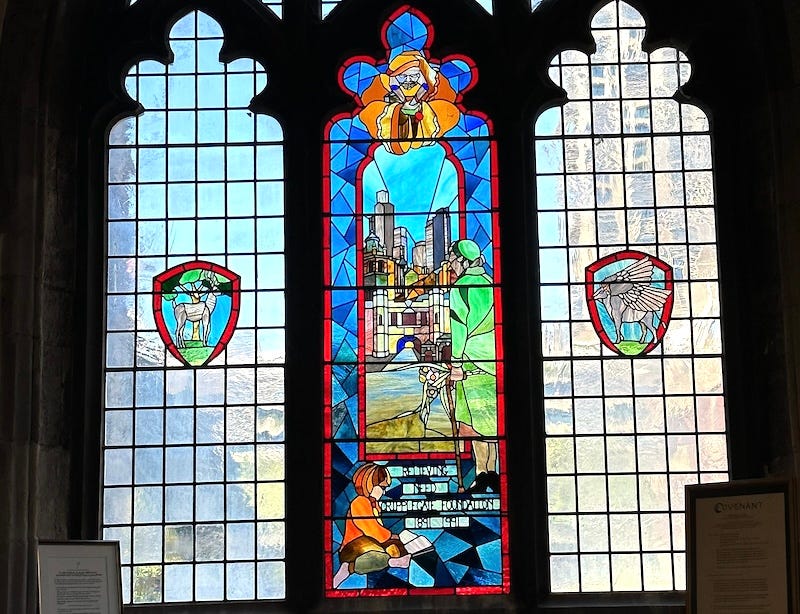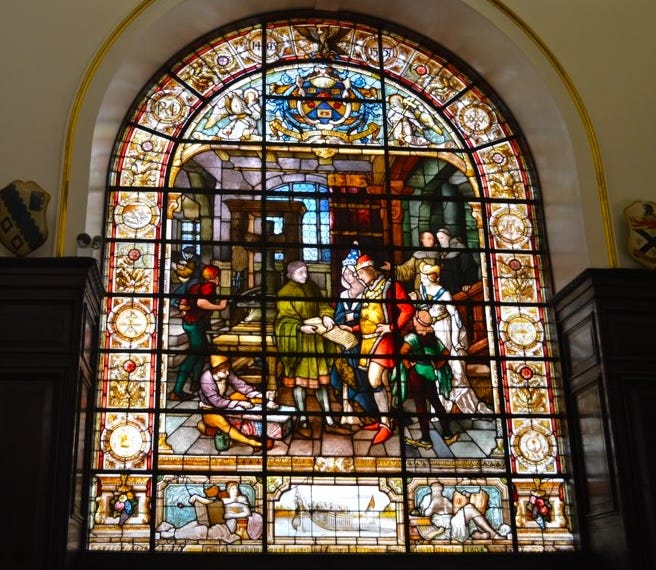Welcome to the Friday instalment of Londonist: Time Machine for paying subscribers, with a generous teaser for everyone else.
Libraries, archives and internet resources can all offer a window into the past. But sometimes an actual window is all that we need. Join me on a visual tour of some of London’s most historical stained glass windows. It’s history at its most transparent.
That’s after the History Radar of upcoming events.
History Radar
Upcoming events of interest to London history fans.
🦴 BONE TOUR: London Month of the Dead continues its sepulchral run throughout the month. This weekend (13 October), you can take a tour of the medieval bone store beneath Spitalfields. And if you find you’re getting a taste for the bones of the Middle Ages, then you can continue the theme in the crypt of St Bride’s on 19 October. Be sure to check out the full Month of the Dead programme for plenty of other talks and tours.
🇨🇳 TASTE OF MEMORY: On 14 October and running for a month, the London Archives in Clerkenwell opens a new exhibition, Taste of Memory, about the lasting influence of Chinese restaurants which popped up in the UK in the early 20th century. Begin by learning about the Chinese Arch which was installed in five Chinatowns across the country, and hear the often-underrepresented voices of the British-Chinese community, including three generations of chefs and their struggles with integrating into British society.
📸 DAVID HOFFMAN: The Museum of the Home opens a new exhibition on 15 October paying tribute to the work of protest photographer David Hoffman, who began working in the East End in the 1970s, documenting issues such as homelessness and racism. Curated by The Gentle Author, the crowdfunded exhibition coincides with the publication of David Hoffman’s monograph, Endurance & Joy in the East End 1971–1987. It runs until 30 March 2024.
🌳 THE WOOD WAR: Did you know about the role that Kew Gardens played in the aeronautical industry during the First World War? On 15 October, the RAF Museum offers a free lunchtime lecture by Dr James Wearn, about how Kew's botanical knowledge was used to construct aircraft out of natural materials such as wood and linen. Watch in person at the museum, or online.
🔥 GREAT FIRE: How did the City recover after the cataclysmic fire of 1666? Join guide Jill French at Guildhall Library on 16 October as she explores how the City was rebuilt.
♥️ A STRANGE MADNESS: There's a chance to get inside the beautifully distressed Annetta House on Princelet Street on 17 October, with an exploration of love and madness in the 17th century, with live lute and theorbo music composed by Dowland, Danyel and Purcell.
✞ WALLED IN: Another Month of the Dead event takes place on 19 October, when my good friend and near-chromatic-namesake Dr Matthew Green talks about medieval anchorites — these are the fellows who had themselves walled into tiny cells, the better to commune with god. Matt’s talking in Brompton Cemetery Chapel, an exceptionally atmospheric venue.
🔫 IWM PODCAST LIVE: History buffs and podcast aficionados are invited to the Imperial War Museum on 19 October for a day of live podcast recordings, covering all manner of topics related to history and conflict. You can pick and choose which sessions you attend, and the day is followed by an evening panel discussion event at the Churchill War Rooms (ticketed separately).
London’s History in Stained Glass
St Dunstan’s in Stepney is arguably London’s third most-famous church dedicated to that saint. Everyone knows the “secret” St Dunstan-in-the-East for its bombed out nave that’s now a peace garden and TikTok magnet. St Dunstan-in-the-West is celebrated thanks to its prime position on Fleet Street.
But St Dunstan’s in Stepney is a bit far out of centre to attract much non-local attention. This is a shame because:
(a) It was built by the saint himself (Dunstan was Bishop of London in the 10th century). You can’t say that about many London churches.
(b) For centuries, this was the only church covering the land east of the City. It’s known as the Mother Church of the East End.
(c) It has a magnificent and unique stained glass window:
Yes, that really is the crucified Christ patrolling the East End skies. He’s the centrepiece of the Blitz Memorial Window, which was crafted in the 1950s to replace glass damaged during the war.
Beneath the crucifixion, we see St Dunstan’s church standing proud among the ruins of the East End. Houses lay in shambles or deleted. Tracts of open space, cleared by the Luftwaffe, are an atavistic throwback to medieval Stepney. But there, in the distance, we can just make out an old gasholder, presumably the Twelvetrees structures near Bromley-by-Bow (EDIT: Now identified as demolished gas holders that once stood on Ben Johnson Road). I’m going to stick my neck out and say that this is London’s only depiction of Victorian gas infrastructure on a stained glass window. But I’d love to be proved wrong.
Stained glass in usually associated with saints and sermons, a visual, multicolour reminder of scripture, from an age when few people could read it for themselves. But the medium has been put to much more versatile use. In this photo-led newsletter, I’d like to share a few examples I’ve spotted around town that offer insights into London’s history. Prepare to be gently dazzled…
The Pedlar of Lambeth
The pedlar of Lambeth is shown with his trusty companion, a dog who is clearly wondering why master is carrying round a corner-unit from a fitted kitchen. This beautifully proportioned window can be found in the Garden Museum, inside the former church of St Mary. It relates the legend of a poor pedlar whose dog uncovered a treasure hoard close to that church. The pedlar used his serendipitous bounty to help the local poor.
The tale is an old one, and has been celebrated here in stained glass for centuries. The current window is from 1956. You can tell it’s 20th century because there, in the background, is County Hall, built from 1911 to house the London County Council. Today, it is home to the Shrek Experience (which, incidentally, has a stained-glass window, of no historical worth). County Hall was built on land once known as Pedlar’s Acre, hence the building’s inclusion on the window. More on the pedlar here.
Stained glass skyscrapers
St Giles Cripplegate is one of very few buildings in the Barbican area to have survived the Blitz (though only just; it is much rebuilt). One of its western windows celebrates the 1991 centenary of the Cripplegate Foundation, a local charity still going strong. As a “time traveller”, I find this window fascinating because the main image combines elements of the local area’s past and present. The skyscrapers of the City, including an identifiable NatWest Tower, rise above the Cripplegate — a long-demolished gateway into the city. The two animals either side, incidentally are a deer (symbol of St Giles) and a winged ox (symbol of St Luke, who is the patron of the neighbouring parish).








